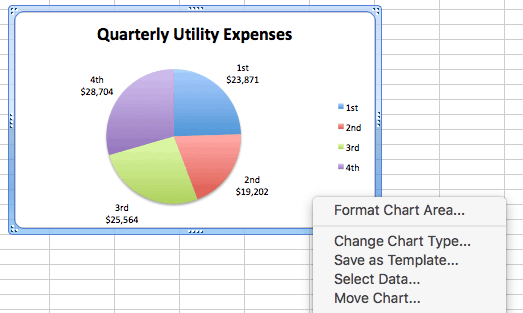
Includes features for integration with iCloud, retina display support and dictation features. Support added for OS X Lion features such as "full screen", "resume", "auto save" and "versioning". The key advances in Numbers are summarised below:Īdds features to allow charts in Keynote and Pages to be automatically updated when changed in Numbers files.
Charts in excel online for mac professional#
The iPad version of Numbers was released in January 2010, and the most recent version of Numbers on OS X is version 3.5 released in November 2014 as part of Apple's iWork '14 update.Īs with other products in the iWork suite Numbers includes a variety of layouts designed by professional illustrators and also includes support for importing documents from Microsoft's Office suite (in this case Excel spreadsheets). numbers file contains many of the standard features of a spreadsheet with support for rows, columns, graphs, formulas and charts. Numbers 1.0 on OS X was first announced on August 7 2007, and the.
Charts in excel online for mac mac os x#
numbers extension are created by Apple's "Numbers" application which forms part of Apple's iWork office suite, a set of applications which run on the Mac OS X and iOS operating systems, and also includes Keynote (for presentations) and Pages (for word processing). Excel 2003 features a 256 colour palette limit whereas later versions allow for unlimited colours.ĭetailed Information on Excel 97-2003 File Format Differences Between Excel 2003 & Excel 2007 Convert files to Excelįiles with a. By comparison, later versions of Excel provide support for over one million rows and 16,000 columns. Excel 2003 limits the user to a maximum of 65,000 rows per worksheet and a maximum of 256 columns. Later versions of Excel make use of a XML for file formats. Microsoft Excel 97-2003 used XLS as the file extension. NUMBERS to Excel - Convert file now View other document file presets Excel provided functionality to a basic user with a requirement to store data in an organised fashion up to advanced users requiring formulas, charts and pivot tables. It was during this period that computers became incredibly popular for both personal and business use resulting in Excel becoming the de facto spreadsheet application. Excel 2000, Excel XP and Excel 2003 all followed featuring tweaks to the appearance and functionality however the core application remained consistent.

The release of Microsoft Excel 97 was a major leap forward in terms of functionality and usability compared to the previous version, Excel 95. Microsoft Excel 1997-2003 is the name of the file type created by four different releases of Microsoft Excel.


 0 kommentar(er)
0 kommentar(er)
